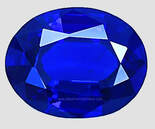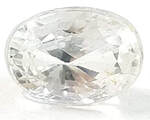Sapphire Prices
With a hardness value that reaches 9 on the Mohs scale, the only stone that beats this value is diamond (diamond) which reaches a value of 10. The hard value attached to diamond causes Sapphire to be the most expensive
Why Sapphires are so expensive, because gemstones are so difficult to find and so few are found in the bowels of the earth. The most expensive sapphire is a natural and crystalline sapphire without human intervention (Untreatment). Most of the best quality sapphires are found in Sri Lanka known as Ceylon Sapphire and in Kashmir (India) known as Royal Blue Sapphire Kashmir.
The price of sapphires is getting more expensive every year. The peak demand for sapphires in the world in 2015, although after the following year the demand for sapphires declined, did not result in the price of sapphires being cheap, especially natural Sapphire crystals and untreatment / non treatment. This is because they buy sapphires not only because of their appearance and efficacy on sapphires but also for long-term investment. Natural sapphires are usually required to issue their gemstone certificates.
The graph of the increase in the price of Natural Sapphire is always the same as the graph of the increase in the price of Gold, because both types of precious objects have a limited amount in nature.
The latest sapphire prices "Based on Sapphire color":
Why Sapphires are so expensive, because gemstones are so difficult to find and so few are found in the bowels of the earth. The most expensive sapphire is a natural and crystalline sapphire without human intervention (Untreatment). Most of the best quality sapphires are found in Sri Lanka known as Ceylon Sapphire and in Kashmir (India) known as Royal Blue Sapphire Kashmir.
The price of sapphires is getting more expensive every year. The peak demand for sapphires in the world in 2015, although after the following year the demand for sapphires declined, did not result in the price of sapphires being cheap, especially natural Sapphire crystals and untreatment / non treatment. This is because they buy sapphires not only because of their appearance and efficacy on sapphires but also for long-term investment. Natural sapphires are usually required to issue their gemstone certificates.
The graph of the increase in the price of Natural Sapphire is always the same as the graph of the increase in the price of Gold, because both types of precious objects have a limited amount in nature.
The latest sapphire prices "Based on Sapphire color":

Blue Sapphire Price, Origin Kashmir, Velvet Blue color, Oval Cutting, Clarity Sapphire (VVS), Crystal, Crack in stone Very smooth, No Heated (Untreatment), 1.64 carat. price: $ 270 / carat.

Yellow Sapphire Price, Origin Sri Lanka, Yellow color, Oval Cutting, Clarity Sapphire (VVS), Crystal, Crack in stone Very smooth, No Heated (Untreatment), 1.64 carat. price: $ 220 / carat.

Green Sapphire Price, Origin Sri Lanka, Green color, Oval Cutting, Clarity Sapphire (VVS), Crystal, Crack in stone Very smooth, No Heated (Untreatment), 1.64 carat. price: $ 230 / carat.
|

Purple Sapphire Price, Origin Sri Lanka, Purple color, Oval Cutting, Clarity Sapphire (VVS), Crystal, Crack in stone Very smooth, No Heated (Untreatment), 1.64 carat. price: $ 230 / carat.

Padparadscha Sapphire Price, Origin Sri Lanka, Pink orange color, Oval Cutting, Clarity Sapphire (VVS), Crystal, Crack in stone Very smooth, No Heated (Untreatment), 1.64 carat. price: $ 250 / carat.

White Sapphire Price, Origin Sri Lanka, White color, Oval Cutting, Clarity Sapphire (VVS), Crystal, Crack in stone Very smooth, No Heated (Untreatment), 1.64 carat. price: $ 200 / carat.
|
Sapphire Prices based on Size (Weight) and Clarity :
|
|
Following is a Summary of Sapphire Prices of Various Levels of Quality and Value:

Lowest value sapphires: These sapphires are the least valuable sapphires. The clarity of the sapphire is between I - SI, where the clarity of the sapphire is very low. Cutting or cut is also a cabochon, so the process of cutting the stone is very cheap. In terms of color, this sapphire shows that the blue is too dark and can even be called the Black Sapphire. 1 carat sapphire can be priced at $ 20

Low value sapphires: These are the least valuable types of sapphires. The clarity of the sapphire is SI (Slight Inclution), where the clarity of this sapphire is low. Cutting or cutting is pretty good, but the corners are not too visible, so the stone cutting process is too easy to process. In terms of color, this sapphire shows that the blue is too dark blue. 1 carat sapphire can be priced at $ 40

Medium value sapphires: These sapphires are the most commonly found sapphires on the market. The clarity of the sapphire is VS (Very Slight Inclution), where the clarity of the sapphire is quite good. Cutting or pieces are very visible visible corners, the process of cutting the stone in the process in more detail. In terms of color, this sapphire shows a slightly sharp blue. 1 carat sapphire can be priced at $ 100

High value sapphires: These sapphires are the rarest and hard to find on the market. The clarity of the sapphire is VVS (Very Very Slight Inclution), where the clarity of the sapphire is quite good. Cutting or pieces are very visible visible corners, the process of cutting the stone in the process in more detail. In terms of color, this sapphire shows sharp blue so that it appears blue cornflower color.1 carat Sapphire can be priced at $ 200
The price of natural sapphire varies depending on 4C namely: Color, Clarity, Carat, Cutting. Besides that the overall quality of the sapphire is also determined based on geographical origin. On the World Market, the best quality sapphires come from Sri Lanka and Kashmir (The border area between India and Pakistan)
To determine Sapphire price, the most dominant is color. The colors on the Sapphire are divided into three components namely: hue, saturation, and tone. Hue is most often understood as the "color" of gemstones. Saturation refers to the clarity or brightness or "colorfulness" of a color, and the tone is light to the color's darkness. Blue sapphires exist in a variety of primary (blue) and secondary mixtures, various tonal levels (colors) and at various levels of saturation (brightness).
To determine Sapphire price, the most dominant is color. The colors on the Sapphire are divided into three components namely: hue, saturation, and tone. Hue is most often understood as the "color" of gemstones. Saturation refers to the clarity or brightness or "colorfulness" of a color, and the tone is light to the color's darkness. Blue sapphires exist in a variety of primary (blue) and secondary mixtures, various tonal levels (colors) and at various levels of saturation (brightness).
Blue Sapphire is evaluated based on the purity of the Sapphire color. Purple, violet and green are the most common secondary colors found in blue sapphire. Violet and purple can contribute to the overall beauty of color. While green is considered clearly negative. Sapphire blue with up to 15% violet or purple is generally said to be of good quality. Sapphire blue with the amount of green as a secondary color is not considered good quality. Gray is a normal saturation modifier or mask found in blue sapphire. Gray reduces saturation or brightness from hue and therefore has a clearly negative effect.
Let's start at the bottom end of the market and work up. The cheapest sapphire is made of decorative stone carvings, because that is what the industry does with low-grade materials that are not suitable for faceted gems or cabins. Carvings tend to be priced in pieces rather than rust, because the work that goes into the manufacture usually exceeds the cost of the material. For sapphire engravings at affordable prices, prices usually range from $ 1-5.00 USD per carat, depending on the quality of the material and whether it has been treated for improvement, besides expertise, of course. Small sapphire carvings can often be purchased from sizes of $ 10-20 per piece, while larger high-end sapphire carvings can cost hundreds to thousands of dollars per piece.
Next in the price order is Sapphire cabochons. A good color material that is not transparent enough to be cut in facets is used to create a dome shape known as cabochon. This is most often found in blue and green, and the color is often available in sizes up to 10 or 20 carats. The price per carat of cabochons tends to be constant without size, and we often have about $ 10 per carat. They can make some very interesting jewelry that has all the virtues of Batu at very affordable prices.
Sapphire stars are also found in cabochons. Here in Thailand, we see several types of star sapphires. Many star sapphires in the range of 1-2 carats often sell for $ 10-20 USD per carat. Larger stones can demand much higher prices, and star treatment that is not treatment or heated can only produce better sapphires. Rare and transparent sapphire stars do exist but most are found in museums.
Prices for blue sapphire that are not treated for color and clarity. Buyers must pay at least $ 300 per carat for 1-2 carat weight cuts with good color saturation. Prices usually increase substantially for quality sapphire gems with a weight above 2 carats. It is difficult to mention the typical market price for sapphires that are not processed well, especially because it is very rare.
Let's start at the bottom end of the market and work up. The cheapest sapphire is made of decorative stone carvings, because that is what the industry does with low-grade materials that are not suitable for faceted gems or cabins. Carvings tend to be priced in pieces rather than rust, because the work that goes into the manufacture usually exceeds the cost of the material. For sapphire engravings at affordable prices, prices usually range from $ 1-5.00 USD per carat, depending on the quality of the material and whether it has been treated for improvement, besides expertise, of course. Small sapphire carvings can often be purchased from sizes of $ 10-20 per piece, while larger high-end sapphire carvings can cost hundreds to thousands of dollars per piece.
Next in the price order is Sapphire cabochons. A good color material that is not transparent enough to be cut in facets is used to create a dome shape known as cabochon. This is most often found in blue and green, and the color is often available in sizes up to 10 or 20 carats. The price per carat of cabochons tends to be constant without size, and we often have about $ 10 per carat. They can make some very interesting jewelry that has all the virtues of Batu at very affordable prices.
Sapphire stars are also found in cabochons. Here in Thailand, we see several types of star sapphires. Many star sapphires in the range of 1-2 carats often sell for $ 10-20 USD per carat. Larger stones can demand much higher prices, and star treatment that is not treatment or heated can only produce better sapphires. Rare and transparent sapphire stars do exist but most are found in museums.
Prices for blue sapphire that are not treated for color and clarity. Buyers must pay at least $ 300 per carat for 1-2 carat weight cuts with good color saturation. Prices usually increase substantially for quality sapphire gems with a weight above 2 carats. It is difficult to mention the typical market price for sapphires that are not processed well, especially because it is very rare.



